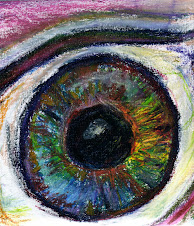I grew up with great vision - well, I didn't need glasses and was an avaricious reader from early on, loved school and always wanted to be a writer and always wrote stuff I hoped other people would read.
The first place I taught was a tiny church-based school in Santa Ana, CA - in around 1978. I taught first grade. A developmental optometrist pioneer in vision therapy did an inservice training workshop for us teachers and I learned how to recognize when a child's vision problems were at the root of their academic difficulties. We toured his amazing vision therapy clinic. I ended up referring about four students to this doctor and all of them benefited by either a prescription for glasses or a series of in-office vision therapy sessions. Then I forgot all about it.
Until....perhaps fifteen years later. Now I was a home-schooling mom with seven children who also taught students from a total of six families over the course of a 17 year period. One daughter struggled with penmanship and resisted any form of written work in spite of being a very fast reader with great comprehension way above her grade level. Another daughter struggled to learn to read and write, made frequent reversals when writing, and could not progress past the primary readers in spite of an obvious ability to comprehend what ever I read aloud to her, and who had an uncanny gift for organizing people and things.
I took the girls to an optometrist at a major store outlet. Both passed the vision examination as far as acuities and ocular health. So they did not need glasses. Fortunately, the doctor had been a student of Dr. Gail Doell at the UMSL -School of Optometry in St. Louis. She taught binocular vision and owned her own optometry practice where she provided in-office vision therapy. The first daughter was diagnosed with a convergence insufficiency which resolved in about 8 weeks. She went on to be an air traffic controller in the US Air Force. The other daughter's problems were more related to visual perceptual developmental delays - they also resolved enough for her to make the dean's list at college every semester and to become a successful accountant. Of course, Dr. Doell became our family's eye doctor forever.
Fast forward another twelve years to 2004. I was in Gail's office for a regular eye exam. My marriage had failed leaving me the single parent of six (my oldest was grown already). This meant that my home-schooling days were ended. The children, enrolled in public schools, all thrived as top students earning scholarships and awards every year. I went back to teaching - in the St. Louis City public schools. I had also earned a Masters in Teaching. Gail and I were laughing over funny stories about my classroom experiences when she happened to mention that she was hiring a new vision therapist. She wanted someone with a graduate degree either in education or occupational therapy to train in-house. Was I interested? After observing several times, I started working for her as a part time vision therapist. Six years later, I still do that in her pediatric office, the Center For Vision & Learning in Creve Coeur, MO.
Most teachers are never told about how fundamental the development of the visual system is to a child's academic success. Many students who are intelligent and excited about learning but who also have undiagnosed learning-related visual problems lose motivation, engage in deteriorating behavior, and become discouraged about their potential success. It begins in kindergarten for many. In fact, many academic challenges could be avoided if every teacher knew how to incorporate activities to improve eye movements and to build visual perception. Even more students would do better at school if every teacher knew how to recognize the symptoms of convergence insuffiencies or excesses and accommodative disorders so they could refer the students to a developmental optometrist who specializes in binocular vision. Special education teachers could help many of their students who have Autism or Asperger's Syndrome by understanding the visual issues these individuals often face and by collaborating with developmental optometrists and skilled vision therapists.
IT IS NOT ENOUGH FOR A CHILD TO PASS THE VISION SCREENING IN THE SCHOOL NURSE'S OFFICE - THIS JUST DEALS WITH DISTANCE VISION AND WITH OCULAR HEALTH - EFFICIENT READING RELIES ON SEVERAL OTHER VISUAL SKILLS
As I participated in optometry training workshops and conferences I discovered that as much as teachers don't know what optometry has to offer, optometrists don't know how classrooms work either. I have experience in the classroom, the homeschool, and the vision therapy contexts. That's why I wrote the Eye Can Too! Read series of curriculum activities for homeschoolers. Of course, they can be adapted for classrooms too. I'm working on a big book of learning related vision activities for the primary classroom learning center now.
Besides finding it personally rewarding to see my patients advance several reading levels within a few months of starting vision therapy and gain self-confidence so that they can begin to enjoy school, I am passionately convinced that the more than 40 years of optometric research about addressing learning-related visual problems through vision therapy activities should be made more widely available. That's why I write this blog and hope to be a resource to parents and teachers for the sake of the kids.
Please feel free to share the links to this blog. Follow me (@lesleybarker) on Twitter and become a fan of the Eye Can Too! Read page on FaceBook. Leave your questions on one of these sites and I'll get back to you with some kind of response that I hope will help.
Subscribe to:
Post Comments (Atom)





No comments:
Post a Comment